Festuca arundinacea
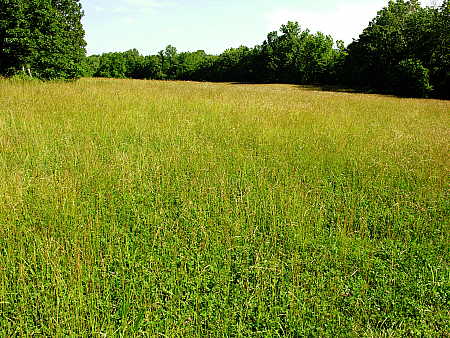
Tall fescue, as pictured in this 5 acre hay field above, is a robust cool season grass that has been imported to the Ozarks region. Tall fescue has major benefits to the farmer, but it also brings with it major headaches.
The major benefit that fescue bestows lies in the relatively diverse growing conditions that it will thrive in.  Fescue will tolerate wet soil and short periods of flooding. At the same time, it is also very draught resistant. Although it grows most vigorously when soil pH, phosphorus and potassium levels are within certain bounds, it will thrive in conditions that are well outside of the recommended ranges. About the only requirement that seems to be absolutely necessary for vigorous fescue growth is an adequate supply of available nitrogen in the soil. Because of the wide diversity of environmental and soil conditions that fescue will thrive under, it has spread throughout the cattle producing regions of the Ozarks. Agronomists have estimated that about 75% of the tall fescue in the Ozarks is infected with a fungus called an endophyte. An endophyte is a fungus that grows within another plant, without causing any apparent harm to the host plant, and in some cases, providing benefits to the host. For fescue, the benefit of the endophyte is that it produces chemicals called “alkaloids” which protect the grass from insects and nematodes. It is said that any square inch of bare soil will soon grow something, as nature abhors a vacuum. If that square inch is in this neck of the Ozarks, most likely it is fescue that will emerge, due to the reasons cited above.
The negative factors pertaining to fescue arise primarily due to the health effects fescue has on livestock. The very endophytes that have caused fescue to predominate in the area also lead to the health risks to animals. The alkaloid ergovaline causes the constriction of the blood vessels in animals. Since cattle rely on increased blood flow through capillaries under the skin for heat reduction in the warmer months, the reduced blood flow as a result of vessel constriction can easily lead to heat stress, which in turn leads to early embryonic death. Another byproduct of fescue induced heat stress is reduced feed intake and decreased animal performance. For horse owners, the endophytes create a condition called fescue toxicity, which can lead to spontaneous abortion or still birth in foaling mares.
For this reason, farmers reactions to fescue are both mixed and intense. It is a grass with robust growth, yet requires careful hay and pasture management to prevent adverse health effects on livestock.
There is much information available to the farmer and rancher regarding fescue management. It can be easily obtained on-line, or through any agricultural extension office. For the homeowner, there is also a large quantity of information available for the best lawn management practices. But for someone like myself, who has many acres of established tall fescue that is NOT being actively grazed by livestock, there is very little information that I have been able to find on how to manage fescue without substantial monetary expenditures. Fortunately, our land is comprised of many fields, and through much experimentation, I have found procedures and schedules that combine to produce lush, green growth at a minimum of expense.
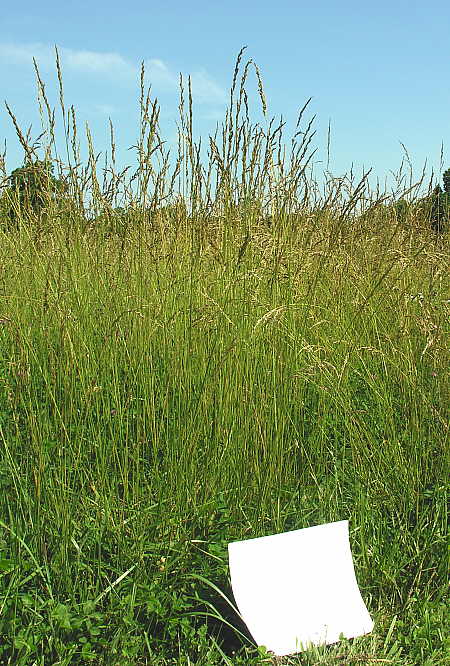
The photo above shows tall fescue at maturity. The white sheet of paper is a standard sheet of 8.5 x 11 paper, which should help to indicate scale. When mature, the fescue reaches a height of 48″ or more. The ample seed head is located at the top of the grass stem.
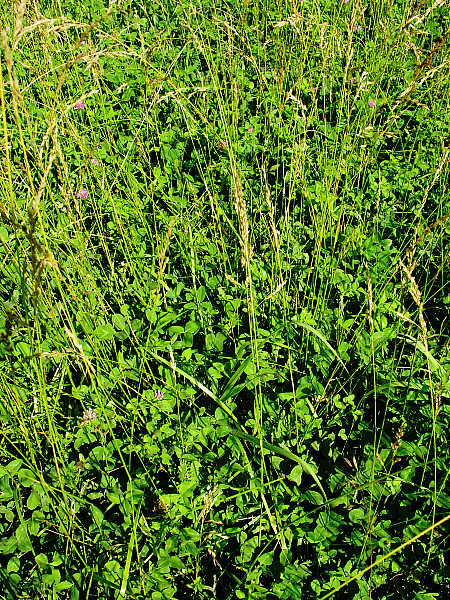
In order to meet the minimum nitrogen requirements that fescue needs to achieve optimum growth, one can rely on either an imported, or an intrinsic nitrogen source. An imported nitrogen source would be the application of any type of fertilizer, either natural or synthetic. This is the routine most farmers would go through, but it requires a considerable annual outlay, in both fertilizer costs, and fuel costs to spread the material. Since we derive no income from the production of cattle, it makes little sense for us to incur these expenses, especially since there is another way to provide nitrogen to the soil. As you can see from the photograph above we rely on an intrinsic nitrogen delivery source – red clover interspersed with the fescue. The clover will supply and fix the nitrogen into the soil, providing the fescue with this all important resource.
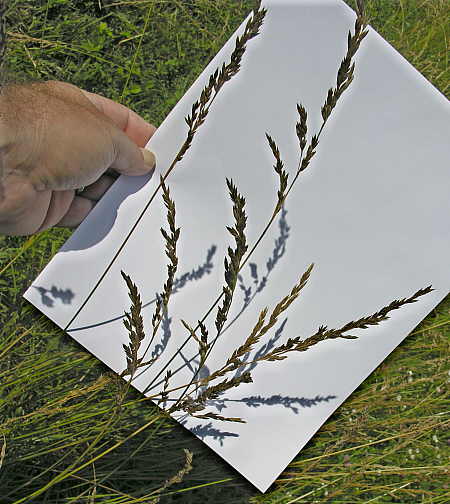
Eventually, the fescue grass will run out of steam and need to be replaced with fresh seedlings. The way that we manage this is to delay the cutting of the fields until such time as the cutting will also serve to re-seed the field. In the photograph above, you can see the seed heads of the fescue grass. Notice that there are no loose seeds on the white sheet of paper. If the fescue field is predominately at this stage, then it is too early to cut. By waiting until the seed head readily sheds its’ seeds when you shake the fescue stem, as shown clearly in the picture below, then any cutting and baling of the fescue grass will result in the loose seeds being sown into the field.
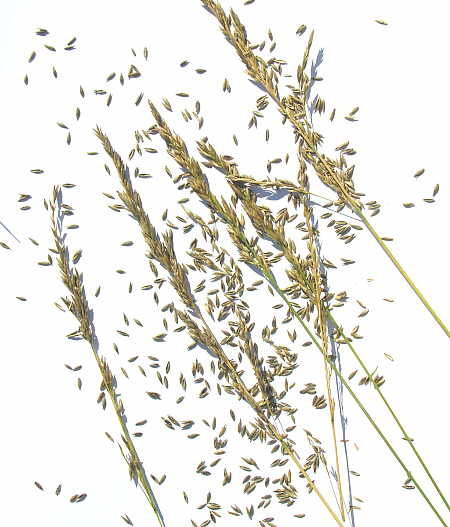
The cutting of the grass, as opposed to just letting it persist throughout the season, serves to eradicate weeds and brush that would otherwise occur in a field of this type. The annual or semi-annual cutting of the fescue, along with the encouragement of natural re-seeding, tends to crowd out any undesirable plant growth, and because of the extremely tolerant nature of the fescue to adverse conditions, it will eventually take over the field.
By following this type of schedule consistently, you achieve a constant re-seeding of the field, and by including clover in the mix, you provide the necessary nitrogen for vigorous fescue growth. And best of all, you will notice that there was nothing that had to be purchased, so the expense is limited to the fuel required for cutting the grass.
What we have found on our land by experimentation is that by allowing the fescue to produce viable seed on a regular basis, and by being persistent with the cutting of the grass, we can produce fields that look like the one that follows, and do it at a very minimal cost.
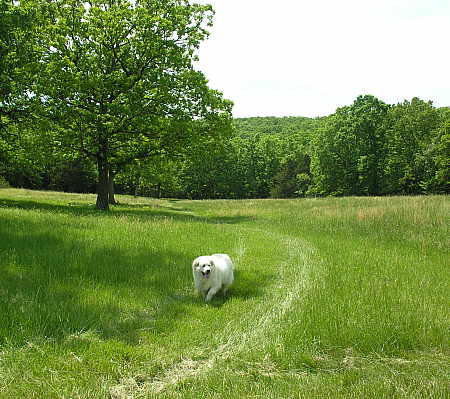
You will have to ask our Pyre Gracie if it is all worth the effort. I think I can see a big smile of approval on her face. Can you?



I see her smile!
A local USDA man called fescue the “grass that ate the county.” Where I don’t have trees at Roundrock, I have fescue, it seems.
Excellent post, by the way.
This was absolutely riveting – and no, I’m not being sarcastic. I love that you go into detail about the options and about how you go about keeping it the way you want it… your way is often better, I think, because you seem to go the natural route quite often.
Kudos on figuring out an inexpensive way to keep your puppy so happy 😉
So much information to digest. There were oats planted on our place that has since been cut into round bales. It wasn’t a very good year, the weeds nearly choked out the oats.
That’s a beautiful field. Whatever you’re doing must be working. Love the use of clover for nitrogen fixing.
Pingback: Ranch Ramblins » Blog Archive » Now You See It, Now You Don’t
Great post! It was just what I was looking for. We planted tall fescue and clover in preparation for winter cattle grazing fields. The information regarding when to harvest was excellent. We too don’t want to go through the cost of reseeding each year but I would like to take advantage of baling. I just wasn’t sure if I would be able to tell when the grass would be ready to reseed itself during/before harvest. The paper test picture is the greatest! Very appreciative in North Carolina!
What mowing equipment do you use? Thank you.
Rich – When cutting for hay production, we use either a sickle bar mower or a rotary mower/conditioner. When cutting for other than hay, we simply use a 7′ bush hog.
Pingback: Ranch Ramblins » Blog Archive » It’s Time For Another Try
is this what they call boot stage,when the seeds are starting to drop.. im more concerned with high nutrition than over seeding. thanks very much,john
John – Yes, this is at the boot stage.
The following article, “Making the Most of Tall Fescue in Virginia”, discusses endophyte problems in fescue at various stages of fescue development, and provides strategies for the optimal timing of hay production. The emphasis is on balancing nutrition and yield with endophyte toxicity.
http://www.ext.vt.edu/pubs/forage/418-050/418-050.html
I have linked to your excellent article of fescue hay and have used one of your pictures. All credit has been given. If you want this taken down please let me know. Thank you, Deb
D. – I am always willing to allow the use of my blog posts for a useful and excellent web site such as yours (http://horsehints.org/).
Thanks for the information on reseeding grass in my hay field,I was not sure when would be the best time to cut if wanting to reseed,now I know it should shake loose before cutting,if there is anything more I should know to make this work I would welcome any information on the topic.
Thanks.
Don
Dear Hal,
I am a professor at the Atlantic Veterinary College and teach on the effects of tall fescue on equine gestation.
Your images of tall fescue are very good. May I have your permission to use these images for teaching? They would appear in some of my lectures and in related material in the internet. You would of course, be acknowledged as the author on all occasions.
Thanking you in anticipation.
Sincerely Rob L
Dr Rob Löfstedt.BVSc. MS. Diplomate ACT
Professor of Reproductive Endocrinology and Clinical Reproduction (Theriogenology).
Department of Health Management
Atlantic Veterinary College at UPEI
550 University Avenue. Charlottetown. PEI.
Canada. C1A 4P3
Tel: 1-902-566-0874
Fax: 1-902-566-0823
e-mail: lofstedt@upei.ca